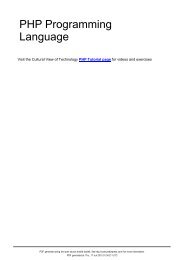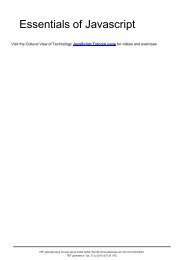Contents - Cultural View
Contents - Cultural View
Contents - Cultural View
You also want an ePaper? Increase the reach of your titles
YUMPU automatically turns print PDFs into web optimized ePapers that Google loves.
Java resource bundle 164<br />
Benefits of using resource bundles<br />
Extracting locale-sensitive objects such as strings from the code (as opposed to hard-coding them) means that the<br />
application can handle multiple locales without having to write different code for each locale. It also means that<br />
translators can deal with just the translatable text and not the programming code. Therefore, using resource bundles<br />
improves the internationalisation and the localisation process of a software product.<br />
Translating a resource bundle<br />
Some CAT tools like OmegaT, OmegaT+ [4] or Sun's Open language tools can specifically handle resource bundles.<br />
In addition to these, translators can use any text editor to create new resource bundles or to modify existing ones.<br />
References<br />
[1] O'Conner, B. Java Internationalization: Localization with ResourceBundles, Sun Developer Network. (http:/ / java. sun. com/ developer/<br />
technicalArticles/ Intl/ ResourceBundles/ )<br />
[2] Java API ResourceBundle Class (http:/ / java. sun. com/ j2se/ 1. 5. 0/ docs/ api/ )<br />
[3] Esselink, B. A Practical Guide to Software Localisation, John Benjamins Publishing (1998).<br />
[4] OmegaT+ (http:/ / omegatplus. sourceforge. net/ )<br />
Java TV<br />
Java TV is a Java-based software framework designed for use on TV set-top boxes, based around components called<br />
Xlets. It is currently used only on the Connected Device Configuration, specifically for iTV applications<br />
development.<br />
The API includes the Xlet classes in the package javax.tv.xlet. Other packages of the public API include<br />
1. javax.tv.graphics - provides a simple rendering canvas<br />
2. javax.tv.locator - provides a locator in the style of a URL for services and media, such as service:/SERV1<br />
3. javax.tv.service - defines a mechanism for service information (SI) databases and APIs representing the SI<br />
elements, such as the TV channels and media available for playback.<br />
Criticisms<br />
While the framework is general, Sun currently provides support only on Java ME. For some subjects, such as media<br />
locators, it is in effect superseded by other locator standards on platforms such as BD-J.<br />
A point of confusion is that in platforms supported as of 2008, examples such as the SvcDispXlet example from the<br />
introduction to the API, written circa 2001, are not deployable because it uses AWT widgets such as java.awt.Button<br />
[1] . Most iTV platforms, along with BD-J, implement Personal Basis Profile with no AWT widgets, as opposed to<br />
Personal Profile which includes the widgets. [2]<br />
Sun's reference implementation for Java TV attempts to limit its exposure to support issues to the full Java Media<br />
Framework by having its own small version of JMF that is internally referred to as "jmflite". As with the limitations<br />
of the MIDP emulators that Sun provides, the Java TV reference implementation provided by Sun has not been<br />
updated to make provisions for later JDK's such as removing calls to Thread.stop(). The Thread.stop() method was<br />
made a "final" method in Java 1.5 (meaning that classes which extend Thread and override stop() will fail at runtime<br />
under JRE 1.5 when the class is loaded). This implies that Sun has not yet committed to public plans or a roadmap<br />
for taking Java ME beyond JRE 1.3. If such an upgrade were to take place, it would require significant work on the<br />
[3] [4]<br />
part of all vendors of Java ME-enabled devices.










